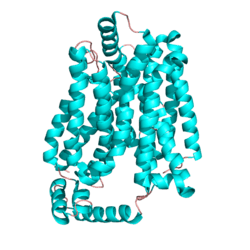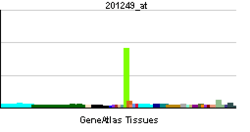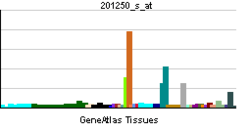GLUT1
| View/Edit Human | View/Edit Mouse |
Glucose transporter 1 (or GLUT1), also known as solute carrier family 2, facilitated glucose transporter member 1 (SLC2A1), is a uniporter protein that in humans is encoded by the SLC2A1 gene.[3] GLUT1 facilitates the transport of glucose across the plasma membranes of mammalian cells.[4]
Discovery
GLUT1 was the first glucose transporter to be characterized. GLUT 1 is highly conserved.[3] GLUT 1 of humans and mice have 98% identity at the amino acid level. GLUT 1 is encoded by the SLC2 gene and is one of a family of 14 genes encoding GLUT proteins[5].
Function
Energy-yielding metabolism in erythrocytes depends on a constant supply of glucose from the blood plasma, where the glucose concentration is maintained at about 5mM. Glucose enters the erythrocyte by facilitated diffusion via a specific glucose transporter, at a rate about 50,000 times greater than uncatalyzed transmembrane diffusion. The glucose transporter of erythrocytes (called GLUT1 to distinguish it from related glucose transporters in other tissues) is a type III integral protein with 12 hydrophobic segments, each of which is believed to form a membrane-spanning helix. The detailed structure of GLUT1 is not known yet, but one plausible model suggests that the side-by-side assembly of several helices produces a transmembrane channel lined with hydrophilic residues that can hydrogen-bond with glucose as it moves through the channel.[6]
GLUT1 is responsible for the low level of basal glucose uptake required to sustain respiration in all cells. Expression levels of GLUT1 in cell membranes are increased by reduced glucose levels and decreased by increased glucose levels.
GLUT1 is also a major receptor for uptake of Vitamin C as well as glucose, especially in non vitamin C producing mammals as part of an adaptation to compensate by participating in a Vitamin C recycling process. In mammals that do produce Vitamin C, GLUT4 is often expressed instead of GLUT1.[7]
Tissue distribution
It is widely distributed in fetal tissues. In the adult it is expressed at highest levels in erythrocytes and also in the endothelial cells of barrier tissues such as the blood–brain barrier.
Structure
GLUT1 behaves as a Michaelis-Menten enzyme and contains 12 membrane-spanning alpha helices, each containing 20 amino acid residues. A helical wheel analysis shows that the membrane spanning alpha helices are amphipathic, with one side being polar and the other side hydrophobic. Six of these membrane spanning helices are believed to bind together in the membrane to create a polar channel in the center through which glucose can traverse, with the hydrophobic regions on the outside of the channel adjacent to the fatty acid tails of the membrane.
Clinical significance
Mutations in the GLUT1 gene are responsible for GLUT1 deficiency or De Vivo disease, which is a rare autosomal dominant disorder.[8] This disease is characterized by a low cerebrospinal fluid glucose concentration (hypoglycorrhachia), a type of neuroglycopenia, which results from impaired glucose transport across the blood–brain barrier.
GLUT1 is also a receptor used by the HTLV virus to gain entry into target cells.[9]
Glut1 has also been demonstrated as a powerful histochemical marker for hemangioma of infancy[10]
Interactions
GLUT1 has been shown to interact with GIPC1.[11]
GLUT1 has two significant types in brain 45k and 55k. GLUT1 45k is present on astroglia of neurons and GLUT1 55k is present on capillaries in brain and is responsible for glucose transport across blood brain barrier and its deficiency causes low level of glucose in CSF (less than 60 mg/dl) which may manifest as convulsion in deficient individuals.
Recently it has been described a GLUT1 inhibitor, DERL3, that is often methylated in colorectal cancer. In this cancer, DERL3 methylations seems to mediate the Warburg Effect.[12]
Inhibitors
Fasentin is a small molecule inhibitor of the intracellular domain of GLUT1 preventing glucose uptake.[13]
Interactive pathway map
Click on genes, proteins and metabolites below to link to respective articles. [§ 1]
Glycolysis and Gluconeogenesis edit
- ↑ The interactive pathway map can be edited at WikiPathways: "GlycolysisGluconeogenesis_WP534".
References
- ↑ "Human PubMed Reference:".
- ↑ "Mouse PubMed Reference:".
- 1 2 Mueckler M, Caruso C, Baldwin SA, Panico M, Blench I, Morris HR, Allard WJ, Lienhard GE, Lodish HF (1985). "Sequence and structure of a human glucose transporter". Science. 229 (4717): 941–5. doi:10.1126/science.3839598. PMID 3839598.
- ↑ Olson AL, Pessin JE (1996). "Structure, function, and regulation of the mammalian facilitative glucose transporter gene family". Annual Review of Nutrition. 16: 235–56. doi:10.1146/annurev.nu.16.070196.001315. PMID 8839927.
- ↑ https://www.ncbi.nlm.nih.gov/pmc/articles/PMC4104978/
- ↑ Nelson DL, Cox MM (2008). Lehninger, Principles of Biochemistry. W. H. Freeman and Company. ISBN 978-0-7167-7108-1.
- ↑ Montel-Hagen A, Kinet S, Manel N, Mongellaz C, Prohaska R, Battini JL, Delaunay J, Sitbon M, Taylor N (2008). "Erythrocyte Glut1 triggers dehydroascorbic acid uptake in mammals unable to synthesize vitamin C". Cell. 132 (6): 1039–48. doi:10.1016/j.cell.2008.01.042. PMID 18358815. Lay summary – ScienceDaily (March 21, 2008).
- ↑ Seidner G, Alvarez MG, Yeh JI, et al. (1998). "GLUT-1 deficiency syndrome caused by haploinsufficiency of the blood–brain barrier hexose carrier". Nat. Genet. 18 (2): 188–91. doi:10.1038/ng0298-188. PMID 9462754.
- ↑ Manel N, Kim FJ, Kinet S, Taylor N, Sitbon M, Battini JL (November 2003). "The ubiquitous glucose transporter GLUT-1 is a receptor for HTLV". Cell. 115 (4): 449–59. doi:10.1016/S0092-8674(03)00881-X. PMID 14622599.
- ↑ North PE, Waner M, Mizeracki A, Mihm MC (January 2000). "GLUT1: a newly discovered immunohistochemical marker for juvenile hemangiomas". Hum. Pathol. 31 (1): 11–22. doi:10.1016/S0046-8177(00)80192-6. PMID 10665907.
- ↑ Bunn RC, Jensen MA, Reed BC (1999). "Protein interactions with the glucose transporter binding protein GLUT1CBP that provide a link between GLUT1 and the cytoskeleton". Molecular Biology of the Cell. 10 (4): 819–32. doi:10.1091/mbc.10.4.819. PMC 25204
 . PMID 10198040.
. PMID 10198040. - ↑ Lopez-Serra P, Marcilla M, Villanueva A, Ramos-Fernandez A, Palau A, Leal L, Wahi JE, Setien-Baranda F, Szczesna K, Moutinho C, Martinez-Cardus A, Heyn H, Sandoval J, Puertas S, Vidal A, Sanjuan X, Martinez-Balibrea E, Viñals F, Perales JC, Bramsem JB, Ørntoft TF, Andersen CL, Tabernero J, McDermott U, Boxer MB, Vander Heiden MG, Albar JP, Esteller M (2014). "A DERL3-associated defect in the degradation of SLC2A1 mediates the Warburg effect". Nature Communications. 5: 3608. doi:10.1038/ncomms4608. PMC 3988805
 . PMID 24699711.
. PMID 24699711. - ↑ Wood TE, Dalili S, Simpson CD, Hurren R, Mao X, Saiz FS, Gronda M, Eberhard Y, Minden MD, Bilan PJ, Klip A, Batey RA, Schimmer AD (2008). "A novel inhibitor of glucose uptake sensitizes cells to FAS-induced cell death". Mol. Cancer Ther. 7 (11): 3546–55. doi:10.1158/1535-7163.MCT-08-0569. PMID 19001437. Retrieved 2015-04-25.
Further reading
- North PE, Waner M, Mizeracki A, Mihm MC (2000). "GLUT1: a newly discovered immunohistochemical marker for juvenile hemangiomas". Human Pathology. 31 (1): 11–22. doi:10.1016/S0046-8177(00)80192-6. PMID 10665907.
- Hruz PW, Mueckler MM (2001). "Structural analysis of the GLUT1 facilitative glucose transporter (review)". Molecular Membrane Biology. 18 (3): 183–93. doi:10.1080/09687680110072140. PMID 11681785.
- Baumann MU, Deborde S, Illsley NP (2002). "Placental glucose transfer and fetal growth". Endocrine. 19 (1): 13–22. doi:10.1385/ENDO:19:1:13. PMID 12583599.
- Mobasheri A, Richardson S, Mobasheri R, Shakibaei M, Hoyland JA (2005). "Hypoxia inducible factor-1 and facilitative glucose transporters GLUT1 and GLUT3: putative molecular components of the oxygen and glucose sensing apparatus in articular chondrocytes". Histology and Histopathology. 20 (4): 1327–38. PMID 16136514.
External links
- GeneReviews/NIH/UW entry on Glucose Transporter Type 1 Deficiency Syndrome
- Glucose Transporter Type 1 at the US National Library of Medicine Medical Subject Headings (MeSH)



